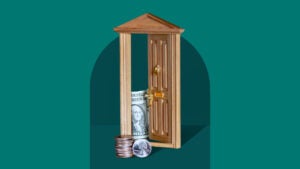Survey finds 74% of homeowners haven’t refinanced despite historically low mortgage rates

Many American homeowners are passing up a prime opportunity to lower their interest rates and cut their monthly payments by refinancing their loans, according to a new Bankrate survey.
As of the end of July, only 19 percent of those with a pre-pandemic mortgage had refinanced since the start of the Covid-19 outbreak. Meanwhile, nearly half (47 percent) had not even considered refinancing. Of those who had not refinanced, nearly one quarter (23%) said it was because they thought it was too much paperwork/hassle.
While the savviest homeowners already refinanced — and some have even done so twice — millions more have yet to take advantage of mortgage rates that once would have seemed unthinkably low. Among homeowners with a mortgage they’ve had since before the pandemic, 74 percent have not refinanced, according to the survey.
“The overwhelming majority of mortgage borrowers have not yet refinanced, despite record-low rates over the past year,” says Greg McBride, CFA, Bankrate chief financial analyst. “Cutting the monthly mortgage payment by $150 or $250, possibly more, can create valuable breathing room in the household budget at a time when so many other costs are on the rise.”
Key findings
- The most common reasons homeowners say they haven’t refinanced
- More than a third of homeowners don’t know their mortgage rate
- Refinance trends vary by generation and income
- The most popular reasons to tap home equity
Bankrate commissioned YouGov Plc to conduct the survey, which consisted of a total sample size of 3,657 adults, including 1,041 with a mortgage. Fieldwork was undertaken from July 26-29, 2021.
The most common reasons homeowners say they haven’t refinanced
Among homeowners who haven’t refinanced, the most-cited reason was that they wouldn’t save enough money to warrant a refi. That choice was named by 32 percent of respondents.
“You may want to rethink that,” McBride says. “Today’s rates are at levels unseen prior to last year.”
To illustrate one example, if you have a 30-year loan for $300,000 at 4 percent, your monthly payment is $1,432. Refinancing to 3 percent would cut it to $1,265, a savings of $167 a month or $2,004 a year. You can use Bankrate’s refinance calculator to see if refinancing will save you money.
Closing costs and fees are the second most-frequently cited objection. Fully 27 percent of respondents named that as an obstacle. It’s true — closing costs can cost you thousands of dollars, typically 3 to 5 percent of the amount of the loan. However, if you can cut your rate significantly, you’ll recoup those closing costs.
Another common objection is that refinancing requires too much paperwork, a hurdle cited by 23 percent of those who have yet to refinance.
“Isn’t saving $30,000 over the next decade worth devoting a few hours of your time?” McBride asks.
Some 14 percent of those who haven’t refinanced said they plan to move or pay off the loan soon. That’s a valid reason not to refinance because it can take years to pay off closing costs, so refinancing is best for homeowners who plan to keep their new mortgages for years.
And 12 percent said their credit scores were too low to refinance. That could be another credible reason not to refinance — most mortgage borrowers in 2021 have higher credit scores. On-time mortgage payments are one of the best ways to boost your credit score, so make sure you’re paying your loan promptly.
Whatever your reason for not refinancing, you should take a closer look, McBride says. “The most-cited reasons for not refinancing might not hold up in this environment of ultra-low rates,” he says.
If you’re concerned about dipping into cash to pay closing costs, consider rolling those costs into the balance of the loan (known as a no-closing-cost mortgage), McBride says.
More than a third of homeowners don’t know their mortgage rate
Some 38 percent of homeowners with a mortgage don’t know their interest rate, including 54 percent of millennials. Those who do know their mortgage rate reported a median rate of 3.57 percent, and an average of 4.57 percent.
Both of those levels are well above current rates, meaning homeowners can reap significant savings with a refi. In separate research, mortgage data firm Black Knight says 15 million American homeowners are in position to save by refinancing.
Tracking down the rate on your mortgage should be a simple matter of checking your monthly statement or contacting your mortgage servicer. If you’re among the homeowners who don’t know your mortgage rate, getting the answer should be your first step. You’ll need to know your current rate to understand whether you’ll benefit from refinancing at current rates.
Refinance trends vary by generation and income
Some 28 percent of millennials (Americans aged 25 to 40) have refinanced, compared with just 17 percent of Gen X (ages 41 to 56) and 17 percent of baby boomers (ages 57 to 75).
Baby boomers are more likely to feel refinancing wouldn’t save them enough money (37 percent, compared with 29 percent for Gen X and 21 percent for millennials). Gen Xers are most likely to point to fees and closing costs as an obstacle to refinancing (34 percent, compared to 27 percent of baby boomers and 20 percent of millennials).
Homeowners with household income over $50,000 are nearly twice as likely to have refinanced (24 percent have done so) compared with homeowners with household income of less than $50,000 (just 13 percent).
The most popular reasons to tap home equity
Bankrate also asked homeowners with a mortgage what they view as good reasons to tap into their home equity. Home improvements or repairs led the way, named by 60 percent of respondents, followed by debt consolidation, cited by 44 percent. Homeowners could cite more than one reason.
Other reasons cited less frequently include: keeping up with regular household bills (19 percent), paying tuition or other education expenses (19 percent), other investments (16 percent) and taking a vacation (7 percent).
How to refinance your mortgage
- Step 1: Set a clear goal. Have a compelling reason to refinance. It could be cutting your monthly payment, shortening the term of your loan or pulling out equity for home repairs or to repay higher-interest debt. You may also want to roll your HELOC into a refi.
- Step 2: Check your credit score. You’ll need to qualify for a refinance just as you needed to get approval for your original home loan. The higher your credit score, the better refinance rates lenders will offer you — and the better your chances of underwriters approving your loan.
- Step 3: Determine how much home equity you have. Your home equity is the value of your home in excess of what you owe your mortgage lender. To find that figure, check your mortgage statement to see your current balance. Then, check online home search sites or get a real estate agent to run an analysis to find the current estimated value of your home. Your home equity is the difference between the two. For example, if you owe $250,000 on your home, and its value is $325,000, your home equity totals $75,000.
- Step 4: Shop multiple mortgage lenders. Getting quotes from multiple mortgage lenders can save you thousands. Once you’ve chosen a lender, discuss when it’s best to lock in your rate so you won’t have to worry about rates climbing before your loan closes.
- Step 5: Get your paperwork in order. Gather recent pay stubs, federal tax returns, bank statements and anything else your mortgage lender requests. Your lender will also look at your credit and net worth, so disclose your assets and liabilities upfront.
Methodology
Bankrate.com commissioned YouGov Plc to conduct the survey. All figures, unless otherwise stated, are from YouGov Plc. Total sample size was 3,657 adults, including 1,041 with a mortgage. Fieldwork was undertaken from July 26-29, 2021. The survey was carried out online and meets rigorous quality standards. It employed a non-probability-based sample using both quotas upfront during collection and then a weighting scheme on the back end designed and proven to provide nationally representative results.





